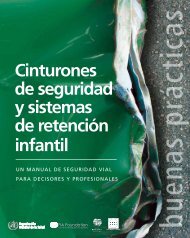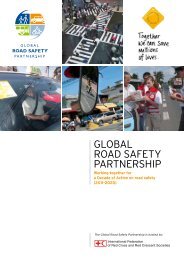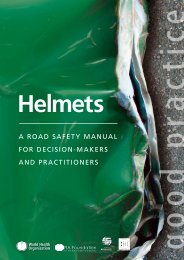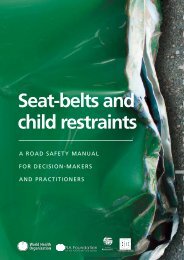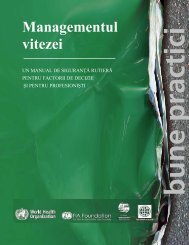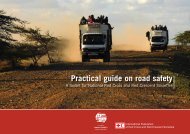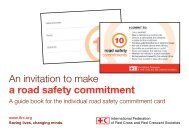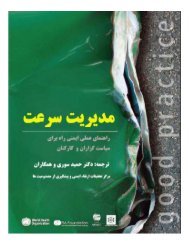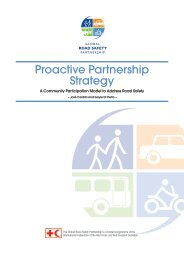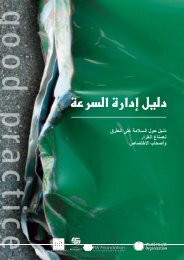How to design and implement a drinking and driving programme pdf ...
How to design and implement a drinking and driving programme pdf ...
How to design and implement a drinking and driving programme pdf ...
You also want an ePaper? Increase the reach of your titles
YUMPU automatically turns print PDFs into web optimized ePapers that Google loves.
Reducing roadside hazards<br />
Drinking <strong>and</strong> Driving: a road safety manual<br />
A high proportion of crashes involving <strong>drinking</strong> <strong>and</strong> <strong>driving</strong> are “run-off road” crashes.<br />
Such crashes will be more severe if they result in a collision with fixed roadside<br />
objects such as trees or electricity poles. As such, action <strong>to</strong> relocate, guard, or remove<br />
fixed roadside objects where drink-<strong>driving</strong> crashes are likely <strong>to</strong> occur should have a<br />
positive impact on the severity of these crashes.<br />
Enhanced information presentation in the traffic system<br />
Visual, perceptual <strong>and</strong> cognitive skills are adversely affected by alcohol <strong>and</strong> it therefore<br />
follows that providing information in a clear <strong>and</strong> easy <strong>to</strong> underst<strong>and</strong> manner will<br />
be important in maximising the performance (<strong>and</strong> thus minimising the crash risk) of<br />
drunk drivers.<br />
Some elements that may enhance information provision include improved guidance<br />
around curves <strong>and</strong> audio-tactile edge lining. Australian field experiments (22)<br />
revealed that of nine roadway delineation treatments trialled by drivers with BAC<br />
of 0.05, the most beneficial form of delineation was chevron alignment signs. These<br />
were shown <strong>to</strong> help drivers negotiate curves. In addition, the use of a wide edge-line<br />
tended <strong>to</strong> reduce the extreme lane positioning common among drink-drivers. Consequently,<br />
the “optimum” delineation treatment appeared <strong>to</strong> be one which combines<br />
chevron alignment signs with a wide edge-line.<br />
It is also important, given the dulled cognitive <strong>and</strong> physical functioning of drunk<br />
drivers, <strong>to</strong> ensure that road geometry <strong>and</strong> delineation are kept as consistent<br />
as possible.<br />
3 | <strong>How</strong> <strong>to</strong> <strong>design</strong> <strong>and</strong> <strong>implement</strong> a <strong>drinking</strong> <strong>and</strong> <strong>driving</strong> <strong>programme</strong><br />
Pedestrians<br />
While alcohol-impaired pedestrians are not a main focus of this manual, this road<br />
user group is at high risk of injury <strong>and</strong> death in road crashes, particularly in low<br />
<strong>and</strong> middle-income countries. For this reason, a few measures are provided below<br />
that have proven effective in reducing the incidence of road crashes involving all<br />
pedestrians.<br />
Lower speed limits<br />
Lower speed limits have the potential <strong>to</strong> improve safety for alcohol-impaired pedestrians<br />
in a number of ways. Gaps in traffic traveling at lower speeds are easier <strong>to</strong> judge<br />
for alcohol-impaired pedestrians. Drivers traveling at lower speeds have greater ability<br />
<strong>to</strong> avoid a collision with a pedestrian, <strong>and</strong>, in the event of a collision, the severity<br />
of the injury will be reduced.<br />
111



